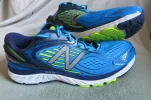Everyone is different, and all feet are different. Even on one person, their two feet are likely different. So, any footwear solution is necessarily highly individualized, and should be tailored to your specific needs.
As regards light running / training shoes versus specialized trail runners or low hiking shoes, I suggest the later for added foot support. Walking the Camino is not the same as a walk across town.
Consider that you will be in these shoes for 8 plus hours each day, in all weather. You will be carrying the added weight of a loaded rucksack, plus water. You will be walking up hills, and down hills. Do consider using hiking poles.
Surprisingly, going down hill is more difficult. Remember, gravity sucks! It WANTS to grab you and hurl you down the hill. Losing your footing makes this easier for Mr. Gravity...
Sometimes you will be walking on flat paved surfaces. However, at other times, you will be walking on broken rocks, gravel and uneven and angled terrain.
The stiffer trail runner and low hiking shoes will provide added stiffness and support to the bottom of your feet when you walk over uneven surfaces with protrusions. Conventional running / training shoes will transmit the pointy bits to your feet.
Stiffer trail runners or low hiking shoes will also provide more torsional support to prevent foot flexing to the side. This is how ankle injuries occur, and they are very common on the Camino.
Moving right along, many of us, myself included, wear mid-height (ankle high) hiking boots. The reasons for this are also personalized. In my case, my body is top-heavy.

Adding a loaded rucksack affects my center of balance in a comical way... Plus, I have weak ankles, always have... Then, literally on top of that, I am not a petite fellow.
So, all of these personal attributes taken together, dictate the need for the added support one gets from mid-height hiking shoes. For reference, for my past five Caminos I have worn Keen Targhee II hiking shoes. I am on my second pair. After a full
Camino Frances, I have them resoled. After three Caminos, my first pair had had enough and I retired them in favor of an identical third pair. In April, they will head out on their third (my sixth) Camino.
Just as an FYI, this shoe is available in a low-cut version and is available for both men and women. It offers excellent torsional stability and sole protection.
Hope this helps.





















